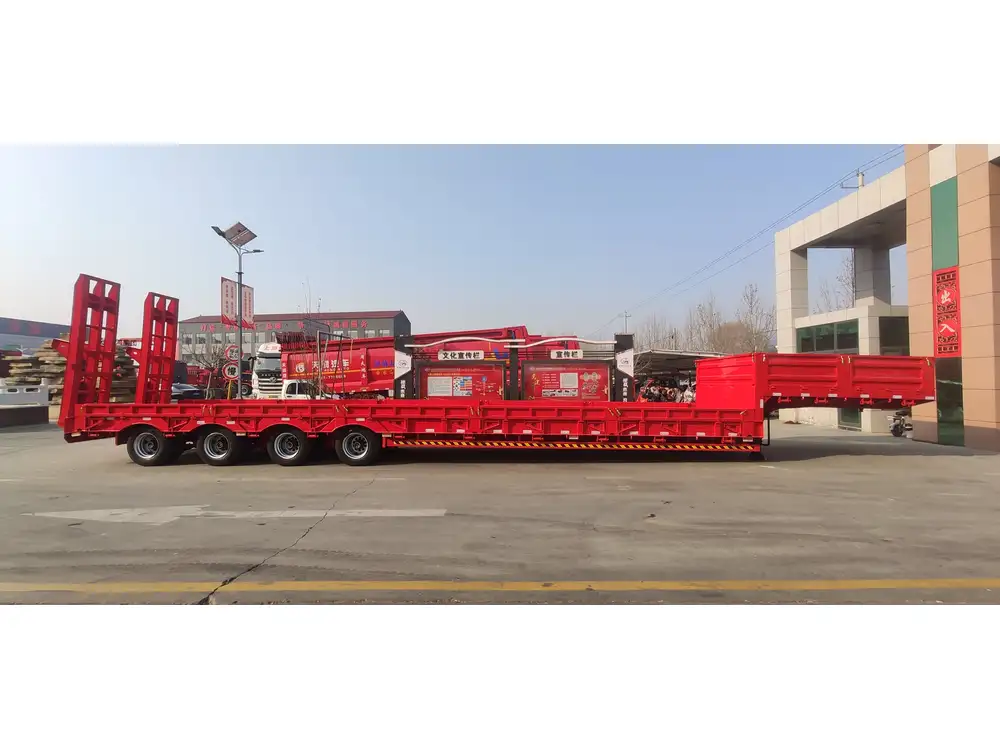Transforming a mobile home into a flatbed trailer is a compelling idea for many who wish to repurpose old structures and maximize utility, often spurred by challenges like relocation limitations, storage issues, or creative DIY projects. This article will delve deep into the conception, technicalities, legalities, and practical considerations surrounding the conversion process.
Understanding the Basics of Mobile Home and Flatbed Trailer Structures
What Is a Mobile Home?
Mobile homes, built primarily for residential living and designed to be transported, consist of a frame, walls, and a roof. They typically include amenities such as plumbing, electrical systems, and insulation. Unlike conventional homes, they can be moved but often require permanent foundations when stationed for long periods.

What Is a Flatbed Trailer?
A flatbed trailer, on the other hand, is a versatile vehicle designed for transporting goods, materials, and sometimes even vehicles. It is characterized by a flat, level surface with no sides or a roof, making it ideal for loading and unloading various cargo types.
Key Differences Between Mobile Homes and Flatbed Trailers
| Feature | Mobile Home | Flatbed Trailer |
|---|---|---|
| Purpose | Residential living | Transporting goods and vehicles |
| Structure | Enclosed with walls and roof | Open, flat surface |
| Legal Specifications | Subject to housing regulations | Governed by transport regulations |
| Foundation | Needs a foundation for stability | Typically remains mobile |
Assessing the Feasibility of Conversion
Before embarking on such a conversion, it’s crucial to assess the feasibility based on various factors:
Condition of the Mobile Home:
- Is the frame strong enough to support the new purpose?
- Structural integrity must be evaluated, including the floor, walls, and roof.
Local Zoning and Regulations:
- Check local laws and regulations regarding modifications to mobile homes.
- Conversion projects may require special permits.
Intended Use:
- Determine what you will use the flatbed for. Different uses may have specific requirements influencing the transformation process.
Technical Skills and Tools:
- Evaluate whether you have the necessary skills and tools for the conversion project.
- Seek assistance if needed; engaging experienced professionals can streamline the process.

Step-by-Step Guide to Convert a Mobile Home to a Flatbed Trailer
Step 1: Planning and Preparation
- Blueprinting: Draw detailed plans including dimensions, materials, and design elements.
- Budgeting: Establish a budget that covers all anticipated expenses, from legal fees to material costs.
Step 2: Disassembling the Mobile Home
Safety First:
- Disengage and disconnect all utilities (water, electricity, sewage).
Structural Removal:
- Remove the siding, roof, and interior components. Preserve any reusable materials.
Frame Analysis:
- Assess the mobile home’s frame for integrity. Prepare to reinforce it if necessary.

Step 3: Modifying the Frame
Reinforcement:
- Strengthen the frame to withstand the weight of cargo. Use steel or high-strength aluminum for additional support.
Height Adjustment:
- Ensure the height of the trailer complies with roadway regulations.
Step 4: Finalizing the Flatbed Configuration
Flat Surface Creation:
- Install a flat bed using plywood or metal sheets. Ensure it’s secured properly.
Weight Distribution System:
- Design a system for distributing weight evenly across the trailer to enhance stability during transit.
Loading Mechanisms:
- Integrate ramps or hydraulic lift capabilities if necessary, depending on the intended use.
Step 5: Legal Considerations and Registration
Compliance Check:
- Ensure that the modified structure meets design specifications for safety and usability.
Registration:
- Contact your local Department of Motor Vehicles (DMV) to register the newly converted flatbed trailer. This process may involve inspections to verify compliance with safety regulations.

Considerations for Safety and Maintenance
- Regular Inspections: Maintain a routine schedule for inspections to ensure the structural integrity of the flatbed and its components.
- Weight Limits: Adhere strictly to weight limits to avoid accidents or damage. Overloading can compromise safety.
- Secure Cargo: Always secure the cargo being transported to prevent shifting during transit, which can disturb balance and pose hazards.
Alternatives to Conversion: What Other Options Exist?
If converting a mobile home into a flatbed trailer seems too cumbersome or unfeasible, consider these alternatives:
- Sell the Mobile Home As-Is: Work with a real estate agent specializing in mobile home sales to find potential buyers.
- Repurposing for Different Use: Instead of a flatbed, transform the mobile home into a storage unit, outdoor guest house, or small studio.
- Purchasing a Flatbed Trailer: Evaluate the cost-benefit ratio of buying a pre-manufactured flatbed. This option saves time and adheres to safety standards easily.
Engaging Readers: Questions You Might Have

What Are the Cost Implications of Such a Project?
The cost of converting a mobile home into a flatbed trailer varies significantly based on the extent of modifications, materials used, and whether you engage professionals for assistance. A DIY approach can save labor costs, but ensure you account for potential unforeseen expenses.
How Long Does the Conversion Process Take?
Depending on your skills and the project’s complexity, the conversion can range from a few weeks to several months. Factors like material availability and weather conditions may impact your timeline.
Are There Environmental Concerns?
Consider the ecological impact of such conversions. Recycling materials from disassembled mobile homes can mitigate environmental effects. Additionally, be mindful of waste disposal regulations.

Conclusion: Weighing the Pros and Cons
Transforming a mobile home into a flatbed trailer presents an intriguing opportunity for creative repurposing. While it requires significant planning, labor, and compliance with legal stipulations, the results can lead to a valuable asset for transportation or construction needs.
Pros of Conversion:
- Cost-effective alternative to purchasing a new flatbed.
- Customization based on personal needs and specifications.
- Repurposing reduces waste and encourages sustainability.
Cons of Conversion:
- Labor-intensive project requiring technical skills.
- Potential legal hurdles and compliance issues.
- May not be feasible based on the mobile home’s condition.
Ultimately, the decision hinges on your specific circumstances, aspirations, and resources. Engaging in a conversion project can be a rewarding venture, provided all factors are meticulously considered and addressed.



